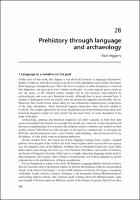Chapter 28 Prehistory through language and archaeology
Proposal review
Abstract
The Routledge Handbook of Historical Linguistics provides a survey of the field covering the methods which underpin current work; models of language change; and the importance of historical linguistics for other subfields of linguistics and other disciplines. Divided into five sections, the volume encompass a wide range of approaches and addresses issues in the following areas: historical perspectives methods and models language change interfaces regional summaries Each of the thirty-two chapters is written by a specialist in the field and provides: a introduction to the subject; an analysis of the relationship between the diachronic and synchronic study of the topic; an overview of the main current and critical trends; and examples from primary data. The Routledge Handbook of Historical Linguistics is essential reading for researchers and postgraduate students working in this area. Chapter 28 of this book is freely available as a downloadable Open Access PDF under a Creative Commons Attribution-Non Commercial-No Derivatives 3.0 license. https://www.routledgehandbooks.com/doi/10.4324/9781315794013.ch28
Book
The Routledge Handbook of Historical Linguistics; The Routledge Handbook of Historical LinguisticsKeywords
LinguisticsPublisher
Taylor & FrancisPublisher website
https://taylorandfrancis.com/Publication date and place
2014Imprint
RoutledgeSeries
Routledge Handbooks in Linguistics,Classification
Linguistics


 Download
Download